 |
General Information about Stockholm

The situation of Stockholm and its appearance are not comparable. At that time, the situation of the city was chosen due to the reason that strategically it was an important place. The type of the buildings are based on a long history that becomes very lively by this illustrative material; What remained conserved is the basic structure of the buildings specially because since several centuries, Sweden is not anymore involved in hostilities.
Geographical situation
With approximately 785.000 inhabitants, Stockholm is the capital of the Kingdom Sweden and at the same time the biggest metropolis of Scandinavia. The city is located at 400 kilometres east from Oslo and at 400 kilometres southwest of Helsinki and at the debouchure of the 120 kilometres long Lake Mälaren in the Baltic Sea. A sluice amidst Stockholm called slussen separates the freshwater of the lake from the saltwater of the sea.
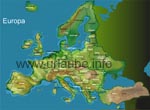
The city area which position is 59°19' latitude degrees north, cut by the 18th longitude degree east, expands over a total of 14 islands that are communicated by 53 bridges. The omnipresence of the water and the bridges provided Stockholm the description of Venice of the North. Located in front of the coast, there are more than 24.000 smaller and bigger islands, that are denominated as skerries, and those, as the Baltic Sea itself, representate a relict of the last ice age.
Consisting on rock and partly overgrown, afforested and/or inhabitaded, they are the work of a mightful ice crust that once moved to the north European continent and left some deep grooves in the bedrock. The melt water of the former glacial-age glacier that in the course of the milleniums continuously moved to the north, forms the Baltic Sea of today.
Stockholm is in the southern third of Sweden, located in the undulated province of Stockholm which relief does not exceed 100 metres. This feature of the area also continues within Stockholm and provides an additional optical attractiveness to the city; Also if the highest rise, the Hammarby Skidbacken, is only 81 m high, the loose differences in altitude loose up considerably the cityscape and offers some wonderful views, either on the cultivated hills as also downwards from them to the wonderful waterways and boulevards.
Weather and Climate
The climate of Stockholm is moderated, the average temperature of the year is of 6,5 degrees and the total rainfall is of 532 millimetres. The coldest month is February with minus 3 degrees, the warmest month with the most rainfalls is July with 17 degrees. Through its northern situation, Stockholm experiences some big differences concerning the sunshine duration. During the high summer, there are up to 18 hours of sunshine per day. Then, it never gets really dark, the sun only disappears for three hours behind the horizon.
Contrary to this, during the Swedish winter, one has to be happy if it gets really bright at all. The day lasts not more than six hours, which does not mean that there is some real daylight, as actually, most of the winter days of Stockholm already run short before they get started at all.
The history of Stockholm
The question when there were the first activities of settlement in the area of what today is Stockholm cannot be fully answered. But what is absolute certain is that the situation between the Baltic Sea and the lake Mälaren was already strategically important from the 13th century, as the region had a high emerge of raw material ressources as iron and copper, but also had some very fertile grounds for the agriculture. The first historical records even mention some pile barriers and a fortification tower that were already built in the 12th century at the place of the oldtown Gamla Stan of today and which purpose was to control the entrance into the lake. This thesis was emphasized by some excavations that took place in the 70ies where some rests of old pile constructions were found.
Stockholm was documentary mentioned for the first time in the year 1252 in a letter of the Regent Birger Jarl Magnussen. He followed the objective to built a fortification in order to guard the access to the Lake Mälaren. Due to this reason, Birger Jarl is considered as the city founder and the year 1252 as the year of foundation. Through the trade activities of the Hanseatic League, Stockholm rapidly developed to the biggest city of Sweden in which towards the end of the 16th century already approximately 10.000 people lived. The main reason for this development was that the inland had a high significance, either agriculturally as also economically, and that Stockholm was originated in a spot where both of the waters that are so important for the trade were connected.
Then, in the year 1471, Sweden, that fought for its independancy of the Kalmar Union, a contract between Sweden, Denmark and Norway, won a battle against the Danish. Not until the year 1520, the Danish King Christian II could capture Stockholm, a thing that led then to the history-charged massacre of Stockholm, a series of executions by the recently crowned Swedish King Christian II, and sealed the end of the Kalmar Union. Three years later, it was Gustav Wasa who took Sweden definetely out of the union by a rebellion headed by himself and thereupon he was choosed for the King. Not much later, the Danish troups were casted out of the country.
The 17th century was a flourishing period for Stockholm, in which the city developed to a cultural and economical centre and controlled the whole area of the Baltic Sea. in the year 1634, Stockholm was officially named as the capital of Sweden. Up to the end of the 17th century, the number of the inhabitants increased to approximately 70.000 people. In many places, the economical boom was also noticeable by some prestige objects; Numerous gorgeous buildings as the Riddarhuset, that can be still admired today, were originated at that time and also the war ship Vasa belonged to these representative objects. But it sank during its maiden trip in the year 1628 after one kolimetrer in front of the coast of Stockholm in the Baltic Sea.
The 18th century first provided a catastrophy to the capital and at the same time ruined the economy. The pest that raged in Stockholm from 1713 to 1714, made the financial situation to deteriorate dramatically, a thing that also had an effect to the infrastructure. Additionally, a major fire destroyed some big areals at the south of the oldtown. The resulting leakage of inhabitants could not be compensated until the economical boom during the second half of the 18th century. Up to the year 1800, the number of inhabitants increased to approximately 80.000, King Gustav III ordered to build some buildings as the opera and the palace and a lot of public places were originated.
But it took half a century until the economical suprimacy of Stockholm within Sweden was recuperated. In the course of the industrialization around the year 1860 there was the necessity to expand the city surface and create some new living space. Some big industrial complexes settled down, scientific academies were originated and numerous immigrants found their way to the reforced economical centre of trade and service.
In order to unify the districts of Stockholm, in the 19th century people started also to expand the infrastructure of the traffic on a grand scale. This included streets, trams, the city motor way and specially the structure of the subway network during the first half of the 20th century. This is what the origination of suburbs and satellite cities as also Industrial and residencial areas benefit.
Today, Stockholm is a naturally grown city that developed around the oldtown centre Gamla Stan. It is the cultural, economical and political centre which main problem is, as in many other metropolis, that there is too less living space. The urbanization continuously expands to te hinterland, but the resulting ecological problems are handled by the city on its own way. As one of the three european capitals, in the year 1997, Stockholm has, beside Oslo and London, introduced the road charge and could manage to reduce the traffic frequency by a quarter.
As the only city world wide, Stockholm has even a National Park of the city that sizes 27 km² and is under natural conservation. It is located in the city island Djurgarden. Since more than 200 years, Sweden was not involved in any warlike conflict, a thing that is also an optical advantage for Stockholm. All historical basic structures of a building are conserved and adorn the streets of houses of today. By this way, the origination of the oldtown Gamla Stan and its concentric growth are well comprehensible.
Arrival
All roads lead to Rome, three roads lead to Stockholm. There are three possibilities to get to Stockholm from Germany. The most time-consuming but also most exciting thing is to drive by car over the Danish Copenhagen and to drive the 7.845 m long bridge to the Swedish Malmö. From there, there are further 600 lonely road kilometres to drive up to the Swedish capital. But those who plan this tour in several stages will really enjoy the journey through the wild-romantic Småland, stay over night in one of the numerous huts (stugor) in the forest at one of the lakes and if a little lucky, even watch the elks. I made the latter with my girlfriend seven years ago, in the autumn time when there are barely tourists in Sweden. During that time, one can spontaneously ask the hut providers that catch one's attention by putting some signs at the main streets, and stay over night there where one likes it most.
At that time, we choosed a hut in a Wals at a lake and when it got dark, with the light of the pocket lamp we found a cross made of branches and grasses behind the hut that was standing on a small hill. It was a little spooky, I have to confess. We let it be and ignored it; Probably, the pet on a family died there, we said to ourselves. Anyhow, on our way to Stockholm we made a boat tour on one of the big lakes, slept in a hut under the roof of a matress stockhouse and even saw some elks.

On the next day, when we wanted them to see again at the same place, we heard three shoots from a distance. After the first one we hoped that the remaining two elks would maybe pass us during their escape, but they didn't. For those who want to try the hut-and-car variant, l warmly recomend: never make use of the first opportutnity to rent a free hut as there are ugly and nice complexes. Better drive first some kilometres further and return if there is something you like, as who wants to stand at a queue of the washhouse with other tourists in Sweden.
The second and most expensive alternative is the transfer with the car ferry. Depending on the harbour of cast off and the harbour of landing between four and forteen hours, and it is partly recommendable to transfer at night and to book a sleeping cabin, as in this case, there is also a tour by car of 600 kilometres waiting for the visitor of Stockholm. But those who, as myself, is clearly taller than 1,90 m, will have to curl into the small beds. But this does not mean at all that the beds are not comfortable. I really enjoyed the seven hours sleep between Travemünde and Trelleborg (TT-Line) and arrived in the next morning in Sweden being fully recovered; And moreover, there is nothing worse than starting the first day of one's holiday being totally exhausted, isn't it? Those who already had a trip to Dover with the night ferry surely know what I am talking about. The dates and prices are available in the internet under www.faehren-schweden.de.
The cheapest and the fastest possibilty at the same time to get to Stockholm is the air way. Those who plan some months previously and cleverly chooses the 10-kg-hand luggage, can already book their two ways flight with Ryan for some few euros. There are some additional costs for the car trip to the airport, the parking fees and the transfer with the bus from the airport to Stockholm, as the low-cost carriers only operate in peripheral airports.
In our case, the resulting costs were as follows: the departure place was Weeze/lower Rhine. The parking fees there were of 8 euros per day and vehicle. From Stockholm/Skavsta, we continued with the airport shuttle bus to the 120 kilometre distant city centre, what cost us 32 euros for both ways. But in total, it was still considerably cheaper than the other two variants of travelling, but also less eventfully. Those who book their ticket via internet and also handles the check-in and the check-out by this way, will have the preference during the seating arrangements in the plane. The Check'n'Go-Priority-Boarding considers even in case of having only paid 18 euro for the flight, that one can access the plane before all other passengers.
Accommodation in the Best Hostel Old Town
It can't be more central and at a more reasonable price: the Best Hostel Old Town in the oldtown Gamla Stan
At ten minutes footway from the main station there is the Best Hostel Old Town in the centre of the oldtown of Stockholm, Gamla Stan. One cannot get accommodated in a cheaper and more central way in the Swedish capital. There are functionally arranged and very well-groomed two- to eight-bed rooms, sufficient showers and WCs at the corridors and one large public room in which one can have some international contacts until late at night.
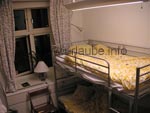
Equipped with a hi-fi unit, IKEA-kitchen, longue, breakfast table and a free access to the internet, it is the first main access point for those who are back to the hostel after 10.00 p.m. but do not want to sleep yet. For a little money one can borrow bedclothes and towels at the reception, the personnel is very friendly and there is, as in whole Stockholm,
ban of smoking within the whole building.
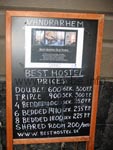
Of course, for an accommodation in Stockholm there are no limits upwards and as in Scandinavia everything except porcelain and ceramic is a little more expensive than in Germany, the price of the Best Hostel Old Town should be considered in this relation. Thus, a night in a double or triple bed room costs 33 euro per person, in the four bed room 28 euro, in a six bed room 26 euro and in a 8 bed room 25 euro per person. It gets the cheapest if as a single person, one gets accommodated in an already busy room, as then there are only 22 euros to pay (prices of 2007). Anyway, in London one would pay for a similar room at least the double or the triple amount.
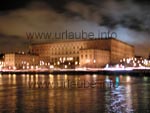
The hostel is hidden behind an historical house front, whereby in Gamla Stan there are only historical house fronts. What is also amazing is the density of the sightseeings right in front of the house door that at night are secured by an electronical code. Those who like to read others emails or want to see a film at a late hour, have simply to stand at the left of the entrrance door and look through the window; There, the gatekeeper projects the screen contence of his laptop to a big screen that is very good visible from outside. Thus, it is recommendable not to mention a bank account within the correspondence with the Best Hostel Old Town.
But back to the sightseeings: the Swedish Academy is at a ten metres distance, the Storkyrkan, the geopraphical centre of Stockholm, is at a distance of 100 kilometres, the Royal palace 300 metres, the Parliament 500 metres and so on. Apart from this, the whole oldtown is a big sightseeing. The rooms in the Hostel Old Town as also in other hotels are possible to book under www.hostelworld.com.
Our trip from Düsseldorf to Stockholm
The dream of a snowy Stockholm in pre-christmas spirit
If one has already the possibility to fly through half Europe by plane for a price with which one also could have paid a train trip of 50 kilometres, one should take it. But this implies that one does not fly every week-end to Milan for having some ice-cream, but according to my opinion, one can access a no-frills airline without having a bad conscience once a year. But those who want to salve one's conscience can donate a voluntary compensation to FairFly, depending on the amount of the CO2-consumption.
The flight from Düsseldorf/Weeze to Stockholm/Skavsta only took approximately 1 hour and 40 minutes. There is to say that both cities after which the respective airports are named are not really close to those cities. From Düsseldorf to Weeze there are 60 kilometres, from Stockholm to Skavsta 120 kilometres. As we abstained from everything what did not match in the hand luggage in order to save costs, at least the waiting time after landing was not too much. As a financial basis, we ordered each 100 euro in Swedish crowns at the bank that resulted in being a wise decision. In the airport, we already got rid of the first 32 euros by paying the two way shuttle service from the airport to Stockholm and back.
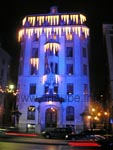
As the airport of Stockholm Skavsta is very small and overseeable, we did not have to look long for the ticket counter nor for the bus. It was only a pity that in the afternoon at 1.00 a.m. it continuously got darker outside. From the hilly and stony landscape, after an hour trip, things were only apparitional recognizable. But therefore, after 80 minutes, Stockholm shined in front of us, first with some less attractive industry belts but then in all its pre christmas gorgeosity. This was not only expressed by the fact that in really every window of a flat building or an office building there was a small illuminated pyramide but also by the fact that all house streets and numerous trees were illuminated.
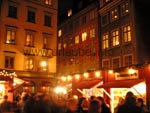
From the bus station, that by the way is one of the most modern ones of Europe, we were supposed to orientate by two towers and to walk towards them, as per our internet-printout. Unfortunately, there was no description of the towers and unfortunately, there were not only two towers. But therefore, there was a McDonald's and it offered some city maps for free on which, thank god, not only the other branches of the burger-chain but also some street names were illustrated. Actually we should have been in our place of accommodation since half an hour, as we finally blocked two four-bed-rooms, but in our wise presentiment we already informed from germany about our delay of arrival per e-mail and got a promt reply saying: "No problem!"
But probably whole Stockholm already knew that we were delayed as we personally asked the first half of the inhabitants for our way while the other half probably already saw our email on the screen of Gamla Stan. Nevertheless, we were good in time. There was indeed not the longed snow but a cold wind and rain, but we were optimistic that soon we would find our place of accommodation. And we found it... in Gamla Stan.
Back to the index Stockholm

Author: Ingo Schmidt; Copyright: Patrick Wagner, www.tourist-guide.biz
|
 |